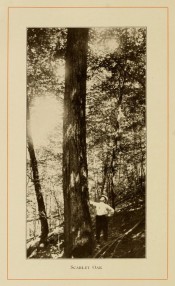Quercus coccinea M?nchh.
Fully-hardy, rounded deciduous tree with pale bark in scaly plates, elliptic, deeply-lobed leaves, to 15cm long, turning red in autumn, and nearly spherical acorns. To 20m. [RHSE, Hortus, Hilliers’].
Horticultural & Botanical History
‘The name is descriptive of the autumn leaves. Artists dispute among themselves whether the leaves are scarlet, red, or crimson. In their opinion a good deal of difference exists between these colors, rendering it quite incorrect to give one color the name of another. As for the artists, they are probably correct in their analysis of colors, but the general public knows the tree as scarlet oak, and it will doubtless be called by that name by most people who speak of the tree in the woods, while those who refer to the wood after it is sawed will speak of it as red oak.
The leaves of scarlet oak are rather persistent, and remain on the twigs late in the season. The brilliancy of this tree is rendered doubly conspicuous, when it is contrasted with the surrounding sombre, winter colors.
In appearance the tree is striking for its delicacy of foliage and twigs. The crown is always narrow and open, and in forest growth is compressed. The height, in good specimens, is about one hundred feet, but it often exceeds that size. In diameter it grows as large as four feet. The mature bark is dark in color and broken into broad, smooth ridges and plates, edged with red. It shows a reddish inner bark when cut and this may be relied upon to identify the tree. The leaves are four or five inches long; deeply sinused, three or four on a side; long, bristle-toothed lobes, broad at the base; acorns bitter, mature in two years; sessile, brown; cup closely drawn in at the edge.
Its range comprises the northeastern quarter of the United States. Beginning in southern Maine, New Hampshire and Vermont, it grows through middle New York, Michigan, Wisconsin, and Iowa to eastern Nebraska. Southward it extends along the coast through Virginia and inland along the mountains to South Carolina and Georgia. The growth is abundant over most of the range, the favorite habitat being dry, gravelly uplands. It seems to be most abundant along the northern part of the Atlantic coast from Massachusetts to New Jersey, and is less common in the interior, and on the prairies skirting the western margins of the eastern forests.’ [Gibson – American Forest Trees p.277/1913].
Introduced to Britain in 1691. [JD].
History at Camden Park
Listed in the 1845, 1850 and 1857 catalogues [T.798/1845]. There are several very old specimens in the Old Orchard, now the property of the Elizabeth Macarthur Agricultural Institute. This avenue of oaks, of mixed species, is thought to have been planted c.1870 as a windbreak for the orchards.
Notes
Quercus coccinea Wangenh. = Quercus robor L. which see.
Published Feb 03, 2010 - 03:00 PM | Last updated Feb 03, 2010 - 05:02 PM
| Family | Fagaceae |
|---|---|
| Category | |
| Region of origin | Eastern North America |
| Synonyms | |
| Common Name | Scarlet oak |
| Name in the Camden Park Record | Quercus coccinea |
| Confidence level | high |
